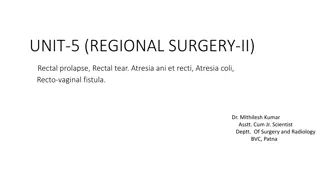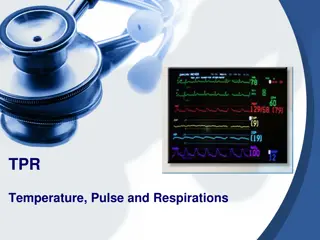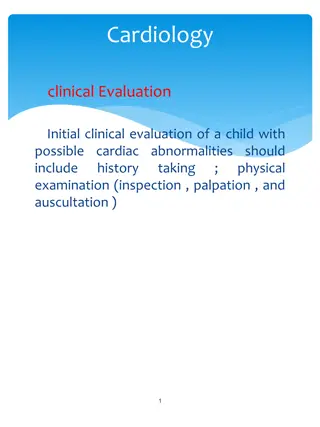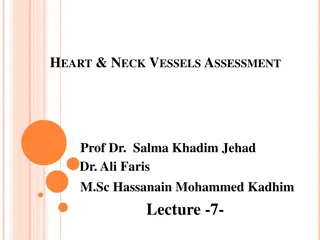Musculoskeletal System Assessment Guidelines
Learn how to conduct a thorough musculoskeletal system assessment, including functional assessments and physical examination guidelines. Explore assessment techniques for ADLs, gait observation, joint palpation, muscle strength testing, and more in nursing practice.
1 views • 17 slides
Rectal Prolapse and Rectal Tears in Animals: Causes and Treatments
Rectal prolapse and rectal tears are common conditions observed in cattle, buffaloes, and small ruminants. Prolonged tenesmus, increased intraabdominal pressure, rectal inflammation, and other factors contribute to the development of these issues. Early diagnosis and treatment are crucial to prevent
2 views • 34 slides
Comprehensive Examination of Head, Ear, Nose, Mouth, and Throat
Learn how to safely and accurately conduct a thorough examination of the head, ear, mouth, nose, and throat, document assessment data, identify problems, and address client's concerns. The examination covers aspects such as symmetry, shape, scalp inspection, palpation, face inspection including colo
0 views • 29 slides
Veterinary Clinical Examination Techniques and Procedures
Learn about the essential veterinary clinical examination techniques including distant examination (inspection), physical examination (palpation, percussion), auscultation, and more. Understand the importance of visual observation, hands-on assessment, and listening to internal organ sounds in diagn
5 views • 24 slides
Understanding Shoulder Anatomy and Common Disorders
The shoulder is a complex joint consisting of multiple components like joints, muscles, ligaments, and capsules. Understanding its anatomy is crucial for diagnosing common disorders such as rotator cuff issues, tendinitis, tears, and frozen shoulder. History, examination, and palpation techniques ar
2 views • 21 slides
Understanding Suppositories: Types, Preparation, and Mold Calibration
Suppositories are solid dosage forms designed for insertion into vaginal or rectal cavities. They can melt, soften, or dissolve to provide localized or systemic effects. Learn about the types of suppository bases, preparation methods, mold calibration, and displacement value calculation in supposito
0 views • 27 slides
Viral Specimen Selection and Collection Overview
Specimen selection for viral testing depends on the suspected viral etiologies and disease syndrome. Throat and nasopharyngeal swabs are used for different viruses, while rectal swabs, urine, blood, and tissue samples are also collected for specific viral detection. Proper specimen transport and sto
0 views • 7 slides
Leprosy Nerve Examination by Dr. N. K. Kansal
This informative content provides a detailed guide on leprosy nerve examination conducted by Dr. N. K. Kansal, an Associate Professor. It covers the procedure for palpation of a nerve, emphasizing correct patient positioning and gentle palpation techniques. The importance of comparing nerves on both
0 views • 16 slides
Understanding Anorectal Malformations in Pediatric Surgery
Anorectal malformations are congenital abnormalities involving the development of the anal canal and sphincter muscles. They may present with imperforate anus, fistulous connections, or rectal atresia. Classification in males and females helps in determining the types of surgical treatments required
0 views • 15 slides
Abdominal Examination in Pregnancy: Techniques and Objectives
Examination of the abdomen in pregnancy involves assessing various aspects such as determining gestational age, measuring symphysis-fundus height, evaluating fetal lie and presentation, checking liquor amount, listening to fetal heart sounds, and monitoring fetal movements. The process includes gene
0 views • 38 slides
Suprapubic Catheter Insertion Procedure Guidelines
Suprapubic catheter insertion is a procedure indicated for conditions such as urethral injury, obstruction, bladder neck masses, and benign prostatic hypertrophy. It involves proper patient positioning, analgesia, equipment preparation, and a step-by-step technique including bladder palpation, marki
1 views • 12 slides
Laboratory Related CRFs for Pharmacokinetics Study
This collection encompasses various CRFs related to laboratory procedures in the context of Pharmacokinetics for a study. It includes forms for enrollment, specimen storage, safety laboratory results, and specific days for sample collection. The CRFs detail the storage, collection, and documentation
0 views • 14 slides
Insights into Structured Reporting Practices in Colorectal Cancer Imaging
A survey conducted by Dr. Eric Loveday at North Bristol NHS Trust revealed the current landscape of structured reporting in MRI and CT scans for rectal and colon cancer. Results indicate a positive outlook towards implementing national standards for structured radiology reporting, with an emphasis o
0 views • 7 slides
Integumentary System Assessment Techniques Lecture
Explore the physical assessment techniques for the integumentary system, focusing on the skin, hair, and nails. Learn about inspection and palpation methods, nail assessment criteria including shape variations, and skin assessment parameters such as color, texture, and pigmentation. Discover how to
0 views • 22 slides
Comparison of Surgical Resection vs. Organ Preservation after Neoadjuvant Chemoradiotherapy for Rectal Cancer
In the management of rectal cancer, the debate between surgical resection and organ preservation after neoadjuvant chemoradiotherapy is ongoing. While surgical resection is highly effective, the watch-and-wait strategy offers benefits such as avoiding permanent stomas and improving quality of life.
1 views • 14 slides
MRI Assessment Findings for Colon and Rectal Cancer
Baseline MRI assessment findings for colon and rectal cancer staging include detailed descriptions of the primary tumor, its borders, extent, muscularis propria involvement, lymph nodes assessment, vascular deposits, circumferential resection margin, peritoneal deposits, pelvic sidewall lymph nodes
0 views • 7 slides
Understanding Temperature Measurement in Healthcare
Temperature, Pulse, and Respirations are vital signs used to assess a patient's health. Temperature can be measured through various methods such as oral, rectal, axillary, tympanic, and temporal routes using different types of thermometers. It's important to know the normal temperature ranges for di
3 views • 39 slides
Understanding Perineal Hernias in Veterinary Surgery
Perineal hernias are a common condition in uncastrated males but can also occur in females and cats. Weakness in the pelvic diaphragm can lead to herniation due to factors like hormonal disorders, prostatic diseases, and rectal issues. The symptoms include swelling in the perineal region, and diagno
0 views • 25 slides
Comprehensive Clinical Evaluation of Children with Cardiac Abnormalities
Initial clinical evaluation of a child with possible cardiac abnormalities includes history taking and physical examination. History should cover symptoms related to pulmonary and systemic venous congestion, cyanosis, cyanotic spells, palpitations, chest pain, and more. The general physical examinat
0 views • 65 slides
Best Practices for Rectal Palpation in Veterinary Medicine
Rectal palpation is a crucial diagnostic method in veterinary medicine for assessing the reproductive health of animals like cows, buffaloes, mares, and camels. This technique helps in determining the normal and abnormal conditions of genital organs, aiding in pregnancy diagnosis and differentiating
0 views • 18 slides
Comprehensive Physical Examination of Head, Face, and Ear
This content provides detailed guidance on conducting a thorough physical examination of the head, face, and ear. It covers objectives such as safely completing the examination, documenting assessment data accurately, and evaluating findings. The preparation, general approach, and specific inspectio
0 views • 21 slides
Comprehensive Physical Examination of Head, Ear, Nose, Mouth, and Throat
This material outlines the objectives and preparations for a comprehensive examination of the head, ear, nose, mouth, and throat, including key assessment techniques such as inspection and palpation. It covers aspects like symmetry, abnormalities, scalp palpation, facial inspection, and more, aiding
0 views • 29 slides
Comprehensive Guide to Physical Examination of Nose, Mouth, and Throat
This detailed guide covers the preparation, general approach, equipment needed, subjective data collection, inspection, and palpation techniques for assessing the nose, mouth, and throat during a physical examination. It includes step-by-step instructions, visual aids, and information on normal find
0 views • 15 slides
Lower Extremity H&P: Foot/Ankle Exam Overview
The lower extremity H&P for foot/ankle examination in orthopedic curriculum involves various steps such as general ortho physical exam maneuvers, inspection for redness and deformities, palpation of specific areas for tenderness and fractures, range of motion assessment, muscle strength testing, and
0 views • 7 slides
Comprehensive Evaluation of the Wrist, Hand, and Fingers
This detailed assessment covers the history, inspection, palpation, and range of motion tests for the wrist, hand, and fingers to evaluate potential injuries or conditions affecting these areas. Includes information on pain location, deformities, ligament evaluations, and joint movements.
0 views • 40 slides
Comprehensive Guide to Abdominal Assessment Methods
Learn the critical order of examination for abdominal assessment, including inspection, auscultation, percussion, and palpation. Understand how to assess skin characteristics, symmetry, abdominal muscles, bowel sounds, vascular sounds, organ size, and tenderness. Discover techniques to identify abno
0 views • 72 slides
Diagnosis-Driven Physical Examination of the Shoulder Part 2: Key Considerations and Case Study
This resource delves into the diagnosis-driven physical examination of shoulder conditions, covering common conditions, key historical factors, and provocative maneuvers for differential diagnosis. It presents an organizational scheme for musculoskeletal assessments and details various shoulder cond
0 views • 34 slides
Heart and Neck Vessels Assessment Overview
This information presents a comprehensive guide for heart and neck vessels assessment, including objectives, necessary equipment, preparation steps, subjective data to consider, techniques for palpating and auscultating the carotid artery, normal findings, and more. It emphasizes the importance of s
0 views • 23 slides
Comprehensive Guide to Integumentary System Assessment Techniques
Learn the essential techniques for assessing the integumentary system, including skin, hair, and nails, through inspection and palpation. Understand how to evaluate nail health based on color, shape abnormalities like spoon shape or clubbing, and texture variations. Explore skin assessment criteria,
0 views • 21 slides
Understanding Treatment Options for Stage III Rectal Cancer
Explore the potential treatments for a 83-year-old male diagnosed with Stage III rectal cancer, including surgery, radiation therapy, chemotherapy, and immunotherapy. Learn about neoadjuvant and adjuvant therapies, complete response definitions, surgical techniques like total mesorectal excision (TM
0 views • 32 slides
Comprehensive Lower Extremity Hip Examination in Orthopedic Curriculum
This detailed guide covers the key components of a hip exam in orthopedics, including inspection, palpation, range of motion assessment, muscle strength testing, and special tests. It emphasizes the importance of considering the joints above and below the hip joint when evaluating a patient's sympto
0 views • 7 slides
Comprehensive Review of Mr. A's Metastatic Rectal Cancer Treatment Journey
Mr. A, a 39-year-old man with metastatic rectal cancer, underwent various treatments including chemotherapy, surgery, and maintenance therapy. Despite some side effects and complications, he showed positive tumor responses and clear margins post-surgery. His treatment involved a combination of Folfi
0 views • 27 slides
Comprehensive Visual and Physical Assessment Techniques for Respiratory Conditions
This comprehensive guide covers the visual, palpation, auscultation, percussion, and pathological processes involved in assessing respiratory conditions. It discusses the impact of chest shape variations like barrel chest, kyphosis, scoliosis, pectus excavatum, and pectus carinatum on respiratory he
0 views • 6 slides
Comprehensive Guide to Neck and Cervical Assessment by Hassanain Mohammed Kadhim
Learn how to inspect the neck for appearance and movement, differentiate between normal and abnormal findings, and perform palpation techniques for the trachea, thyroid gland, and cervical lymph nodes. Discover the important landmarks and characteristics to assess during a neck examination.
0 views • 13 slides
Updated Guidance on Colonic Imaging Tests for Various Symptoms
The new NICE guidance outlines recommended tests based on different symptom complexes, emphasizing the importance of starting with the main symptom, such as rectal bleeding or abdominal mass. Specific tests like flexible sigmoidoscopy, colonoscopy, or CT scans are suggested depending on age and fitn
0 views • 5 slides
PrEP Use and STIs Association Study Among YMSM/TGW in Chicago
A longitudinal cohort study by Ethan Morgan, Ph.D., examined the link between Pre-Exposure Prophylaxis (PrEP) use and rectal Sexually Transmitted Infections (STIs) among young men who have sex with men and transgender women in Chicago. The study found no significant relationship between PrEP use and
0 views • 6 slides



































